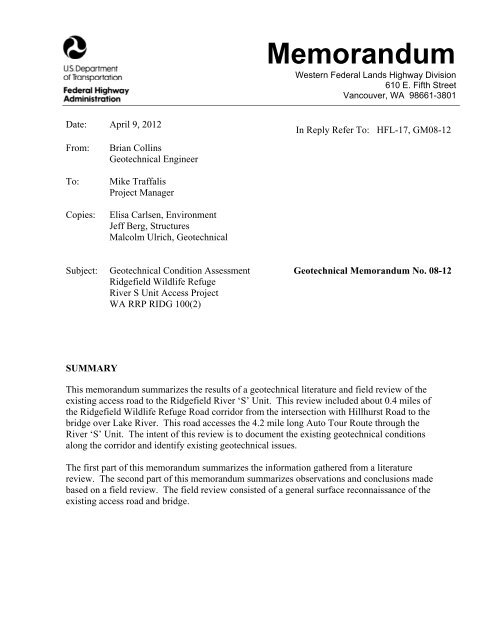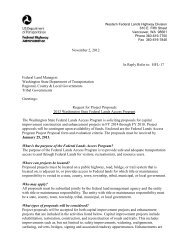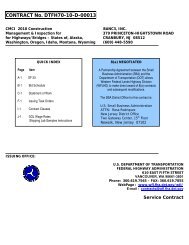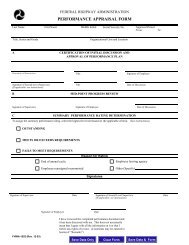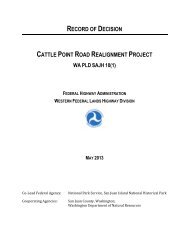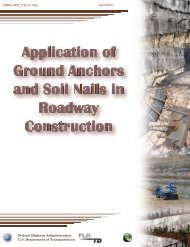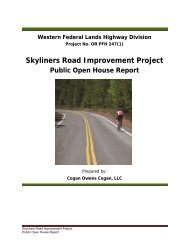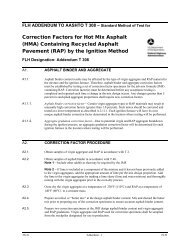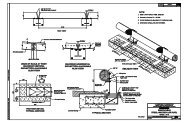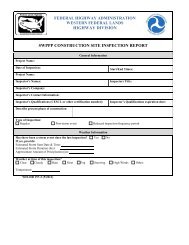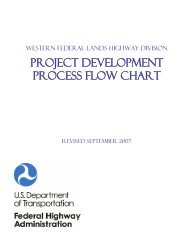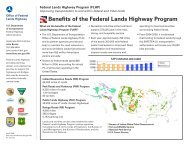Memorandum - Western Federal Lands Highway Division - U.S. ...
Memorandum - Western Federal Lands Highway Division - U.S. ...
Memorandum - Western Federal Lands Highway Division - U.S. ...
Create successful ePaper yourself
Turn your PDF publications into a flip-book with our unique Google optimized e-Paper software.
<strong>Memorandum</strong><br />
<strong>Western</strong> <strong>Federal</strong> <strong>Lands</strong> <strong>Highway</strong> <strong>Division</strong><br />
610 E. Fifth Street<br />
Vancouver, WA 98661-3801<br />
Date: April 9, 2012<br />
From:<br />
Brian Collins<br />
Geotechnical Engineer<br />
In Reply Refer To: HFL-17, GM08-12<br />
To:<br />
Copies:<br />
Mike Traffalis<br />
Project Manager<br />
Elisa Carlsen, Environment<br />
Jeff Berg, Structures<br />
Malcolm Ulrich, Geotechnical<br />
Subject:<br />
Geotechnical Condition Assessment<br />
Ridgefield Wildlife Refuge<br />
River S Unit Access Project<br />
WA RRP RIDG 100(2)<br />
Geotechnical <strong>Memorandum</strong> No. 08-12<br />
SUMMARY<br />
This memorandum summarizes the results of a geotechnical literature and field review of the<br />
existing access road to the Ridgefield River ‘S’ Unit. This review included about 0.4 miles of<br />
the Ridgefield Wildlife Refuge Road corridor from the intersection with Hillhurst Road to the<br />
bridge over Lake River. This road accesses the 4.2 mile long Auto Tour Route through the<br />
River ‘S’ Unit. The intent of this review is to document the existing geotechnical conditions<br />
along the corridor and identify existing geotechnical issues.<br />
The first part of this memorandum summarizes the information gathered from a literature<br />
review. The second part of this memorandum summarizes observations and conclusions made<br />
based on a field review. The field review consisted of a general surface reconnaissance of the<br />
existing access road and bridge.
Literature Review<br />
AVAILABLE SUBSURFACE INFORMATION<br />
WFLHD was provided with a Geotechnical Report for the Ridgefield Rail Overpass Project off<br />
of Pioneer Street west of downtown Ridgefield, about ¾ mile northwest of the Ridgefield<br />
access Bridge. The report contains 5 boring logs from the site of the proposed Ridgefield Rail<br />
Overpass. It is interpreted that the soil types encountered will be similar at the Ridgefield<br />
Wildlife Refuge Road. The borings generally encountered layers of unconsolidated silt, clay<br />
and fine sand overlying very dense sand and gravel.<br />
SITE CONDITIONS<br />
The Ridgefield Wildlife Refuge Road begins at the intersection with Hillhurst Road at about<br />
elevation 265 feet. It follows a natural drainage down to Lake River descending to about<br />
elevation 15 feet. Before the road crosses the river, it crosses a double set of railroad tracks. A<br />
lidar map of the access road is attached as Figure 1 (attached).<br />
The existing Lake River Bridge is a 331.5 foot long, single lane, timber trestle structure with<br />
19 spans originally built in 1970, and in 1980 two spans were replaced with a single span<br />
through an agreement between the Refuge and a private contractor to facilitate movement of<br />
barged equipment along Lake River. The 55.5 foot main span is composed of steel beams and<br />
the 18 other spans vary in length from 8 feet to 17 feet and are spanned by timber beams. The<br />
16 foot wide deck consists of transverse timber planks, longitudinal timber running planks with<br />
timber bridge rail and curbs. The trestle bents and abutments contain timber piles, bracing and<br />
caps. All timber is noted to be treated.<br />
SITE GEOLOGY<br />
The site is within the geologic province known as the Puget-Willamette Lowland which<br />
extends from Puget Sound into west-central Oregon between the Coast Range and the Cascade<br />
Range. Ridgefield is near the deepest part of the basin which is believed to have been filled<br />
with as much as 550 m of sediments carried in from the east by the Columbia River (Evarts,<br />
2004).<br />
The surficial geology of the site is mapped and described on the Geologic Map of the<br />
Ridgefield Quadrangle, Clark and Cowlitz Counties, Washington (Evarts, 2004). Descending<br />
from the intersection with Hillhurst Road, the soils along the access road are mapped as<br />
cataclysmic-flood deposits (Qfs), conglomerate (QTc), and alluvium (Qa). The cataclysmicflood<br />
deposits are described as unconsolidated clay, silt, and fine to medium sand. The<br />
conglomerate is described as semi-consolidated pebble and cobble gravel that is poorly sorted<br />
to moderately well-sorted and contains minor lenses of cemented sand generally less than 2 m<br />
Page 2 of 10
thick. The conglomerate layer is often locally included as part of the Troutdale Formation.<br />
The alluvium is described as unconsolidated sediments underlying the modern floodplains of<br />
the Columbia River and Lake River.<br />
GEOLOGIC HAZARDS<br />
Geologic hazards relevant to this site were reviewed as part of this corridor assessment. Clark<br />
County has an online map database that identifies landslide, liquefaction, and erosion hazards.<br />
The USGS Earthquake Hazards Program website was used to perform a seismic deaggregation<br />
for the site and locate nearby active faults.<br />
<strong>Lands</strong>lides<br />
The cut slopes and natural slopes within the drainage along the road are mapped as “potential”<br />
and “moderate” under <strong>Lands</strong>lide Hazard Areas in the Clark County Maps Online database for<br />
Slopes and Geologic Hazards. See attached Figure 2 (attached).<br />
Seismicity and Liquefaction<br />
The USGS interactive deaggregations website was used to determine the seismic hazard at the<br />
site. The current AASHTO Bridge Design Specifications (2012) specify a design seismic<br />
event with a 7 percent probability of exceedance in 75 years which is approximately a 1000-<br />
year return period. The peak ground acceleration for the specified return period was<br />
determined to be 0.28g using the USGS 2008 deaggregation website. The closest active fault<br />
is the Portland Hills Fault located about 11 miles south of bridge. The deaggregation indicates<br />
the sources contributing significantly to the seismic hazard at the site are the Cascadia<br />
Subduction Zone (megathrust and floating), western US gridded crustal faults, and 50-km deep<br />
intraplate earthquakes.<br />
In the Clark County Maps Online database for Slopes and Geologic Hazards the Liquefaction<br />
hazard along most of the alignment is mapped as “very low” and “very low to low”. However,<br />
the low and flat-laying area on both sides of the bridge is mapped as a “moderate to high”<br />
liquefaction hazard. See attached Figure 3 (attached).<br />
This bridge site has a seismic hazard and subsurface conditions that would require special<br />
consideration during design of a replacement structure.<br />
Erosion<br />
In the Clark County Maps Online database for Slopes and Geologic Hazards the entire<br />
drainage that parallels most of the access road and the slopes facing Lake River are mapped as<br />
a “Severe Erosion Hazard Area”. See Figure 4 (attached).<br />
Page 3 of 10
Page 4 of 10
Site Observations<br />
Brian Collins, WFLHD Geotechnical Engineer, and Jeff Berg, WFLHD Structural Engineer,<br />
visited the site on March 27, 2012. The field review consisted of a general surface<br />
reconnaissance of the existing access road and bridge. It should be noted that the extent of the<br />
field review is limited to interpretations of surface features.<br />
SLOPE INCLINATIONS<br />
The existing road template appears to have generally been constructed with a partial cut bench<br />
on the uphill side and a fill on the downhill side. Both the cut and fill slopes are relatively<br />
steep with slope angles ranging from 40 degrees (1V:1.2H) to vertical. Natural slopes within<br />
the drainage were generally between 30 degrees (1V:1.75H) to 40 degrees (1V:1.2H). A<br />
photograph of a typical roadway section is shown in Figure 5.<br />
Figure 5. Photo of Typical Road Section, Looking Northwest (towards Lake River).<br />
SOIL AND GROUNDWATER<br />
The soil types observed in the existing cut slopes were consistent with the descriptions on the<br />
geologic map. Near the top of the hill the soils exposed were visually classified as silt with<br />
some clay, moist, brown, low plasticity. Further down the road the steeper and higher cuts<br />
exposed conglomerate that was visually classified as gravel and cobbles in a fine to medium<br />
grained silty sand matrix, subrounded to round gravel and cobbles, 6-inch minus. Near the<br />
lower end of the alignment a layer of weakly cemented fine to medium sand with silt was<br />
Page 5 of 10
observed underlying the conglomerate. Seepage was observed in this area just above the<br />
contact of the two layers. See Figure 6 below.<br />
Figure 6. Photos of conglomerate (left) and sand (right) layers.<br />
LANDSLIDES<br />
A fairly significant landslide was observed on the opposite side of the drainage from the road.<br />
See location of landslide in Figure 1 (attached) and photo of landslide in Figure 7. The<br />
landslide encompassed an area of about one acre. It appears from the age of the trees on top of<br />
the slide mass that it occurred within the last 20 years. The slide is not impacting the roadway;<br />
however, if continued movement dams the drainage, it could cause significant flooding and<br />
erosion or a larger failure that could have significant impacts to the existing road.<br />
Page 6 of 10
Figure 7. <strong>Lands</strong>lide Observed Across Drainage from Refuge Access Road.<br />
Several smaller slumps were observed in the native slopes throughout the drainage. These<br />
slumps are shown as shallow bowl shaped depressions in the lidar imagery of Figure 1<br />
(attached). The shallow slumping does not appear to be a significant problem other than<br />
having the potential to deposit debris on the road during heavy precipitation events.<br />
The shallow slumps and also the larger landslide previously mentioned are commonly<br />
observed throughout this geologic formation mapped as conglomerate by Evarts (2004). As<br />
previously stated, this formation is often included as part of the Troutdale Formation. The<br />
formation consists of very dense and slightly cemented gravel and cobbles so it will stand at<br />
vertical slopes as observed along this road. However, when the material becomes saturated it<br />
loses significant strength often resulting in landslides ranging from shallow slumps to massive<br />
ground movements; both observed with the drainage that the Refuge access road follows.<br />
Slopes in the conglomerate are sometimes cut vertical to minimize the amount of precipitation<br />
that directly impacts the slope. Once the slope deviates from vertical it must be laid back to an<br />
angle that will be stable considering the amount of precipitation that it will be exposed to.<br />
Generally these materials would be stable at slopes of 1V:1.5H or flatter.<br />
The vertical cuts in the conglomerate material were 30 to 40 feet high along the Refuge access<br />
road. The slope had about 10 feet (measured vertically) of accumulated sloughed material at<br />
the toe. The angle of repose of the sloughed material was between 35 degrees (1V:1.5H) to 40<br />
degrees (1V:1.2H).<br />
DETENTION BASIN<br />
A detention basin was observed on private land near the intersection with Hillhurst Road. See<br />
aerial photo in Figure 8 showing its location. The detention basin is situated on the level<br />
Page 7 of 10
ground at the top of the slope above the road. It was not inspected since it is on private<br />
property.<br />
Storage of water, even if temporary, at the top of a slope can raise the local groundwater table<br />
and increase the likelihood of landslides.<br />
DETENTION<br />
BASIN<br />
Figure 8. Aerial Photograph of Refuge Access Road (2012 Google Earth).<br />
BRIDGE<br />
Routine bridge inspections have been performed by other agencies. Jeff Berg, WFLHD<br />
Structural Engineer, also performed a site visit and existing condition assessment. His findings<br />
are provided in a separate memorandum.<br />
The west abutment was reconstructed between 2008 and 2010 and the piles and cap appeared<br />
to be in good condition. The timber piles, pile cap, and wingwall at the east abutment had<br />
moderate to heavy rot (as documented in the 2010 Bridge Inspection Report). The piles, pile<br />
cap, and wingwalls also exhibit visible rotation (See Figure 9). The piles in the river were not<br />
accessible, but the Inspection Report also indicates moderate to heavy rot in the piles above the<br />
water line.<br />
This bridge was originally constructed in 1970. The durability of timber piles is a function of<br />
the site conditions. The durability if most effected when timber piles are subjected to alternate<br />
wetting and drying cycles that leads to damage and decay by insects.<br />
Page 8 of 10
PILE<br />
Figure 9. Picture of East Abutment, note Pile Rotation.<br />
The FHWA Driven Pile Foundations Manual (Hannigan et al, 2006) lists the expected<br />
durability for round timber piles as follows:<br />
<br />
<br />
<br />
<br />
Timber piles permanently below the groundwater table will typically last indefinitely,<br />
Treated trestle piles over land will generally last about 75 years in northern states,<br />
Treated piles in fresh water will typically last 5 to 10 years less than land trestle piles in<br />
the same area, and<br />
Treated marine piles will typically last about 50 years in northern climates.<br />
Data from a USGS gage station on the Refuge Road access bridge indicates that the water level<br />
of the river fluctuates twice daily with magnitudes up to 2 feet. This is interpreted to be related<br />
to tidal influence. Due to the highly variable water level and the observed rot the piles should<br />
be considered to be in a marine environment when interpreting the durability and the expected<br />
service life should be 50 years.<br />
Considering the short spans and the relatively lightweight superstructure, it is interpreted that<br />
the piles have relatively small loads. However, since the piles are nearing their expected<br />
service life and there is observed moderate to heavy rot an analysis of the pile loads versus the<br />
remaining pile capacity is recommended. The remaining pile capacity could be established<br />
following an inspection and coring of the piles in the river. This should be done during low<br />
water so the cores can be taken in the zone that experiences the most fluctuation in water level.<br />
Page 9 of 10
References<br />
2002 Interactive Deaggregations, USGS Earthquake Hazards Program,<br />
http://eqint.cr.usgs.gov/deaggint/2002/index.php, accessed 3/22/2012.<br />
2008 Interactive Deaggregations, USGS Earthquake Hazards Program,<br />
https://geohazards.usgs.gov/deaggint/2008/, accessed 4/09/2012.<br />
Bridge Inspection and Appraisal Report, Lake River Bridge No. 13551-00007, Ridgefield<br />
National Wildlife Refuge, Region 1, U.S. Fish & Wildlife Service, Prepared by Geocal, Inc.,<br />
and Short Elliot Hendrickson, Inc., Submitted by U.S. Fish and Wildlife Service.<br />
Clark County Maps Online, Liquefaction, <strong>Lands</strong>lide Hazard Areas, Severe Erosion Area,<br />
http://gis.clark.wa.gov/imfmol/imf.jspsite=pub_mapsonline, accessed 3/22/2012.<br />
Duquette, J. and Albright, S., Ash Creek Associates, Inc. (2007) Design Level Geotechnical<br />
Engineering Study, Ridgefield Rail Overpass Project, Ridgefield, Washington, prepared for<br />
Jacobs Engineering Group, Inc., 37pp.<br />
Evarts, R.C. (2004) Geologic Map of the Ridgefield Quadrangle, Clark and Cowlitz Counties,<br />
Washington, Scientific Investigations Map 2844, U.S. Department of the Interior, U.S.<br />
Geological Survey.<br />
Hannigan, P.J., Goble, G.G., Likins, G.E., and Rausche, F. (2006) Design and Construction of<br />
Driven Pile Foundations, FHWA Report No. FHWA-NHI-05-042, National <strong>Highway</strong> Institute,<br />
<strong>Federal</strong> <strong>Highway</strong> Administration, U.S. Department of Transportation, Washington, D.C., 968p.<br />
USGS National Water Information System: Web Interface, USGS 14213090 Lake River at<br />
Ridgefield, WA, http://waterdata.usgs.gov/wa/nwis/uv/site_no=14213090&PARAmeter_cd=00060,00065,<br />
accessed 3/28/2012.<br />
Page 10 of 10


